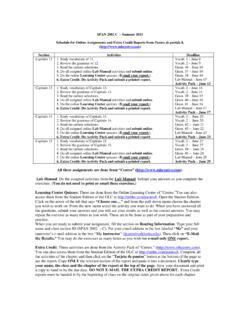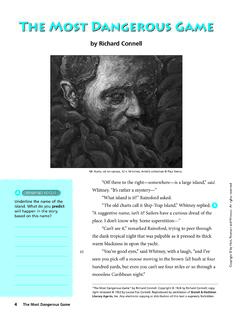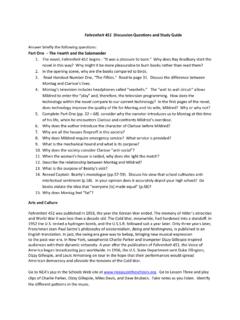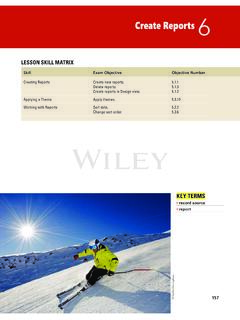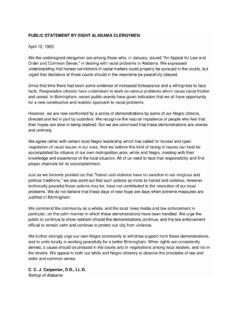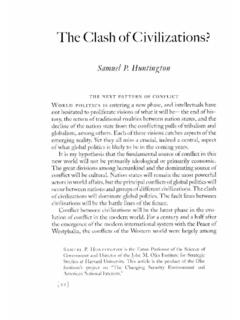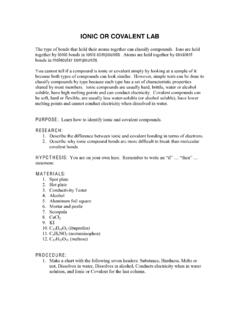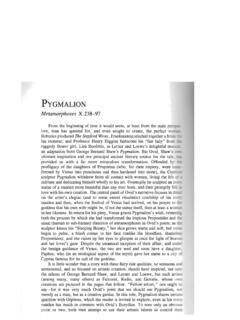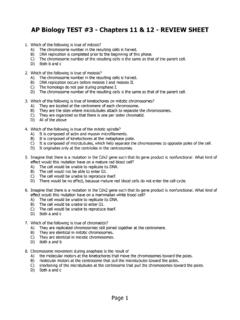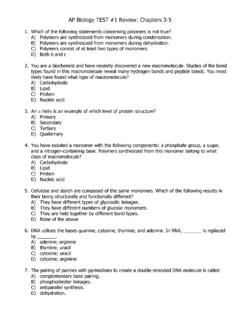Transcription of Chapter 5
1 Chapter 5 Populations and Communities Adapted from Holt biology 2008 Adapted from Holt biology 2008 Chapter 5 Section 1: Populations & Communities Key Vocabulary Terms Adapted from Holt biology 2008 Population A group of organisms of the same species that live in a specific geographical area Adapted from Holt biology 2008 Carrying Capacity The largest population that an environment can support at a given time Adapted from Holt biology 2008 Content Objectives I will be able to identify: The importance of studying populations. The difference between exponential & Logistic growth. The factors that affect population size. How science & technology have affected human population growth.
2 Adapted from Holt biology 2008 Adapted from Holt biology 2008 Adapted from Holt biology 2008 Chapter 5 Section 1: Populations & Communities Notes Adapted from Holt biology 2008 Adapted from Holt biology 2008 Adapted from Holt biology 2008 Chapter 5 Section 1: Populations & Communities What is a Population? Adapted from Holt biology 2008 Adapted from Holt biology 2008 Adapted from Holt biology 2008 YOUR TURN Active Reading Section 1 Populations? Characteristics of Populations: Geographic Distribution (range) : where the organisms live. Adapted from Holt biology 2008 Characteristics of Populations: Population Density: the number of individuals per unit area.
3 Adapted from Holt biology 2008 Characteristics of Populations: Growth Rate Adapted from Holt biology 2008 THINK, SHARE, WRITE TSW #1 What distinguishes one zebra population from another zebra population? THINK, SHARE, WRITE TSW #1 What distinguishes one zebra population from another zebra population? A Zebra population consists of a group of zebras that live together and interbreed. A different zebra population lives separately from the other population and does not interbreed with that population. Adapted from Holt biology 2008 Adapted from Holt biology 2008 Chapter 5 Section 1: Populations & Communities Population Growth Adapted from Holt biology 2008 Four factors that affect population size Number of births Number of deaths Immigration Emigration Adapted from Holt biology 2008 Population Growth Occurs when the individuals in a population reproduce at a constant rate.
4 Adapted from Holt biology 2008 Population Growth Curves Under ideal conditions with unlimited resources, a population will grow exponentially. Adapted from Holt biology 2008 Population Growth Curves Exponential growth is also known as J-shaped. Adapted from Holt biology 2008 Exponential Growth Adapted from Holt biology 2008 THINK, SHARE, WRITE, (TSW) #2 What are the characteristics of a population that grows exponentially? THINK, SHARE, WRITE, (TSW) #2 What are the characteristics of a population that grows exponentially? A population that grows exponentially grows slowly when it is small but grows quickly as it gets larger.
5 An exponential growth curve is kind of in a J shape Logistic Growth Occurs when a population s exponential growth slows or stops. Adapted from Holt biology 2008 WHY Logistic Growth ? Resources get used Adapted from Holt biology 2008 Population Growth Curves Logistic Growth S Curve Adapted from Holt biology 2008 Population Growth Curves Adapted from Holt biology 2008 Complete the analysis for the Quick Lab - Population Growth Adapted from Holt biology 2008 Adapted from Holt biology 2008 Chapter 5 Section 1: Populations & Communities Factors That Affect Population Size Adapted from Holt biology 2008 GROWTH LIMITS Different factors limiting population growth: BIOTIC or ABIOTIC.
6 GROWTH LIMITS Limiting Factors: a situation that causes a decrease in population growth. Adapted from Holt biology 2008 Density-dependent limiting factors: Factors that depend on population size. Examples: competition, predation, disease Adapted from Holt biology 2008 Density-independent limiting factors: Factors that affect ALL populations, regardless of size. Examples: weather, natural disasters, humans Adapted from Holt biology 2008 7 THINK, SHARE, WRITE, (TSW) #3 Describe the differences between biotic and abiotic factors. THINK, SHARE, WRITE, (TSW) #3 Describe the differences between biotic and abiotic factors. Biotic factors are living factors that affect a population s growth.
7 Abiotic factors are nonliving factors that affect a population s growth. Adapted from Holt biology 2008 Adapted from Holt biology 2008 Chapter 5 Section 1: Populations & Communities Human Population Adapted from Holt biology 2008 Historical Overview of Human Population Growth For much of human history, the population grew very SLOWLY. Adapted from Holt biology 2008 Historical Overview of Human Population Growth About 500 years ago, the human population started growing MUCH FASTER. Adapted from Holt biology 2008 HUMAN POPULATION HUMAN POPULATION Adapted from Holt biology 2008 Predictions Some scientists think that in 50 years, the population will grow to 9 billion.
8 Adapted from Holt biology 2008 HUMAN POPULATION Adapted from Holt biology 2008 Demography The statistical study of human populations. 5 Demographic Transition The tendency for a population s birth and death rates to slow down. CAUSES?? Adapted from Holt biology 2008 Age Structure Diagrams (Population profile) This shows the number of females and males within different age groups. Adapted from Holt biology 2008 Demography: Age Structure Diagram THINK, SHARE, WRITE, (TSW) #4 How have advances in technology allowed the human population to grow faster ? THINK, SHARE, WRITE, (TSW) #4 How have advances in technology allowed the human population to grow faster?
9 By improving sanitation, controlling disease, and allowing for more efficient production of food. Adapted from Holt biology 2008 Adapted from Holt biology 2008 Chapter 5 Section 2: Interactions in Communities Key Vocabulary Terms 6 Adapted from Holt biology 2008 Predation An interaction between two organisms in which one organism (the predator) kills another (the prey) Adapted from Holt biology 2008 Coevolution The evolution of two or more species that is due to mutual influence Adapted from Holt biology 2008 Parasitism A relationship between two species where one benefits (the parasite) and the other species is harmed (the host)
10 Adapted from Holt biology 2008 Symbiosis A relationship in which two organisms live in close association Adapted from Holt biology 2008 Mutualism A type of symbiosis where both organisms benefit Adapted from Holt biology 2008 Commensalism A type of symbiosis where one organism benefits and the other is neither helped nor harmed Adapted from Holt biology 2008 Content Objectives I will be able to identify: How predator-prey interactions influence both predators and prey. Five other types of interactions in a community. Adapted from Holt biology 2008 Adapted from Holt biology 2008 Adapted from Holt biology 2008 Chapter 5 Section 2: Interactions in Communities Notes Adapted from Holt biology 2008 Adapted from Holt biology 2008 Adapted from Holt biology 2008 Chapter 5 Section 2: Interactions in Communities Predator- Prey Interactions Adapted from Holt biology 2008 Predator-Prey Relationships Species in various relationships develop adaptations in response to one another.
